|
Related FAQs: Sea Squirts,
Ascidians 2, Ascidian ID, Ascidian Behavior, Ascidian Compatibility, Ascidian Selection, Ascidian Systems, Ascidian Feeding, Ascidian Disease, Ascidian
Reproduction,
Related Articles: Live Rock, Review of Tyree's "Cryptic
Filtration" Book, Sponges,
/The Conscientious Reef Aquarist
Almost Us!? Sea
Squirts, Tunicates, Ascidians, Subphylum Urochordata, Phylum
Chordata Pt. 4
To: Pt. 1,
Pt.
2, Pt. 3,
Pt. 5,
|
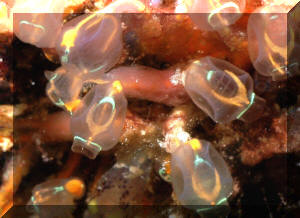
|
|
By Bob Fenner
|
|
Genus Leptoclinides:
| Leptoclinides cf. reticulatus (Sluiter
1909). An encrusting species of thin, membranous make-up. Dark grey
with yellow-white siphon interiors. Shallow water reefs of the
Western Pacific. N. Sulawesi pic. |
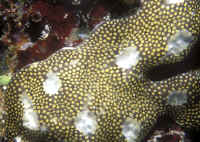 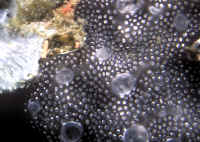
|
Bigger PIX:
The images in this table are linked to large (desktop size) copies.
Click on "framed" images to go to the larger size. |
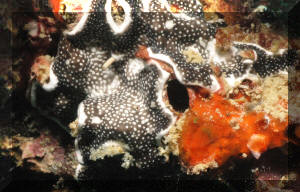
%20MD.JPG) |
Genus Lissoclinum:
| Lissoclinum fragile Monniot &
Monniot 1987. Western Pacific; Australia to Polynesia. This colony
in the. Encrusting colonies that are soft and fragile. Oral and
cloacal openings numerous, distributed throughout the colony. White
with magenta siphon openings. |
|
| Lissoclinum cf. vareau Monniot &
Monniot 1987. Western Pacific; Australia to Polynesia. This colony
in the. Encrusting colonies that are soft and fragile. Oral and
cloacal openings numerous, distributed throughout the colony. White
with magenta siphon openings. Ari Atoll, Maldives pic. |

|
Genus Nephtheis: Monotypic
| Nephtheis fascicularis (Drasche 1882), the/a Lollipop
Tunicate. Shallow reefs of Indonesia (and P.I.?). Not photosynthetic (a
filter feeder on small life). N. Sulawesi
image. |
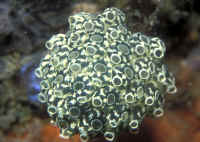
|
Bigger PIX:
The images in this table are
linked to large (desktop size) copies. Click on "framed"
images to go to the larger size. |
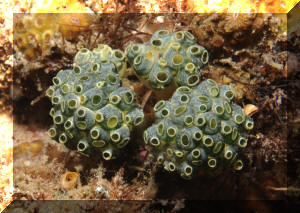
%20MD.JPG) |
Genus Pachyclavella:
| Pachyclavella sp. N. Sulawesi image (Lembeh
Strait). |

|
Bigger PIX:
The images in this table are linked
to large (desktop size) copies. Click on "framed" images
to go to the larger size. |
|

|
Genus Perophora:
| Perophora modificata Kott 1985. Western
Pacific; Australia, Indonesia, Philippines. Zooids in dense
clusters, with short stalks. Transparent lemon-yellow in color.
Here in Bunaken/Sulawesi/Indo. |
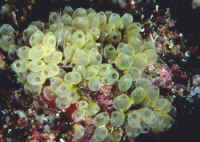
|
Bigger PIX:
The images in this table are linked to large (desktop size) copies.
Click on "framed" images to go to the larger size. |
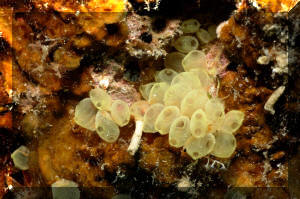
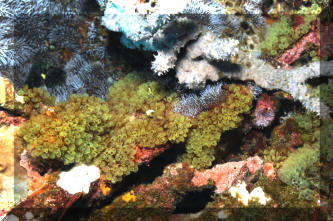 |
| Perophora namei Hartmeyer & Michaelsen
1928. To less than 10 cm. in length, counting stalk. Ovoid, bluish
zooids. Western Pacific; Indonesia, Philippines, Coral Sea. S.
Sulawesi/Indo. |
.jpg)
|
Bigger PIX:
The images in this table are linked
to large (desktop size) copies. Click on "framed" images
to go to the larger size. |
|
%20MD.JPG)
%20MD.JPG)
|
| Perophora viridis Verrill 1871. Honeysuckle Tunicate.
Colonial, tropical W. Atlantic. Common in nutrient-rich lagoons under
ledges, overhangs. Pale yellow w/ visible yellow lines w/in. About
1/2" zooids. Cozumel pic. |

|
Genus Polyandrocarpa:
| Polyandrocarpa polypora A stalked Ascidian... Fiji
2017 |
%20MD.JPG)
|
Bigger PIX:
The images in this table are linked
to large (desktop size) copies. Click on "framed" images
to go to the larger size. |
|
%20MD.JPG)
|
Genus Polycarpa:
| Polycarpa aurata (Quoy & Gaimard 1834).
Indo-Pacific; Australia, New Guinea, Indonesia, Philippines,
Micronesians. This image made off of the north of Lombok,
Indo. |
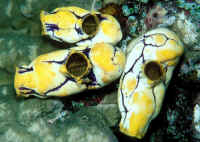
|
| Verticals (Full/Cover
Page Sizes Available) |
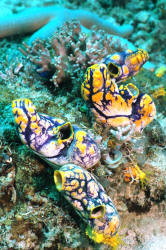 |
Bigger PIX:
The images in this table are linked
to large (desktop size) copies. Click on "framed" images
to go to the larger size. |
|

|
| Polycarpa pigmentata (Herdman 1906).
Distinctive, independent polyps with thick leathery tunics, bright
white-dotted siphon interiors. N. Sulawesi image. |
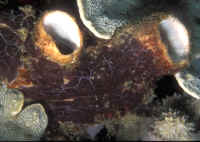
|
Bigger PIX:
The images in this table are linked
to large (desktop size) copies. Click on "framed" images
to go to the larger size. |
|
%20MD.JPG)
|
| Polycarpa spongiabilis, Giant Tunicate.
Globular shaped. Siphons appear lined w/ inward facing bars at edge. To five
inches. Roatan 2016. TiffB pic. |
%20MD.JPG)
|
Genus Pycnoclavella:
| Pycnoclavella sp. Heron Island, QLD,
GBR |
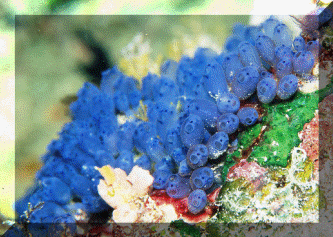
|
Bigger PIX:
The images in this table are linked to large (desktop size) copies.
Click on "framed" images to go to the larger size. |

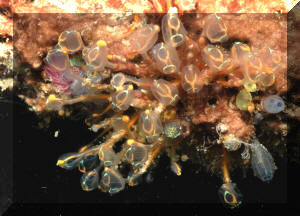 |
To: Pt. 1,
Pt. 2,
Pt. 3,
Pt. 5,
|
|

